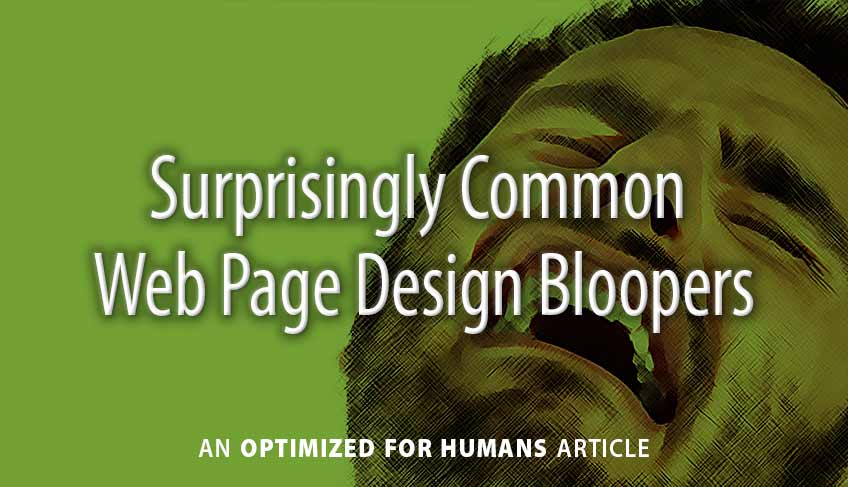
B Y T O M T O R T O R I C I
Designers are hired to make things look good, and overall they succeed. But there’s a problem.
The problem is, even the best web page designers can get so caught up in their own mission, they can forget that the site’s audience isn’t made up of other style-minded designers. It’s made up of other people with their own mission to fulfill.
In other words, as digital craftspeople focus on how something looks, they may fail to put the same level of attention into how it reads.
If their attractive web page design inadvertently pushes people away instead of drawing them in, whoa, that sort of negates the intention of the company that hired them in the first place. Unfortunately, this scenario is far more prevalent than anyone seems to realize.
Okay, for context, let’s look at where your eye first lands on a web page, or an ad in the Sunday paper, or pretty much anything else.
Typically, it’s a spot at the upper left of the page, but not all the way in the corner. Then, left to its own devices, attention tends move down and to the right.
Now, consider a web page design where a block of text under the main banner runs along the left margin of the page. Extremely common right? Now, after the eye leaves the banner and begins its downward-rightward path, asking it to make a sharp right turn to catch the first word at the left edge is actually a pretty big ‘ask’.
In the real world, attention is just as likely to follow its natural momentum, and completely bypass that core selling message you really, really wanted them to read.
Think I’m crazy? I’m not the one to say. But before you pass judgement, pay close attention to how your own eye moves through a new web page.
The solution to the above problem? Indent the whole block of text, so it’s closer to the page’s visual center of gravity, rather than beginning on the edge of the page, where the eye doesn’t naturally venture. Or at least indent the first line, and put the first few words in bold, in a larger font. Trust me on this, you’ll catch the eye of far more readers.
Now that we know more about the eye’s path, and its general avoidance of the page’s edges, does it make any sense to put essential info in the top right corner of a page?
Yes, people do tend to look up there for something specific and transactional, like a ‘Log In’ button. But, say, a call-to-action squeezed up in that corner is unlikely to get much love.
Same thing with a main menu that’s too close to the top edge of a page. You want people to see that menu, so they’ll be encouraged to dig further into your site. So consider putting that menu below the main banner rather than above it, and your reader’s eyes are much more likely to land on it.
True professionals know that in web page design, readability comes first, aesthetics second.
The last issue I’m going to crab about today concerns written content that appears close under a large image or block of color. That content is in effect visually buried, and the roaming eye is more likely than not to just skim past it. So sad.
The solution here is easy: just leave some ‘air’ i.e. white space above and to the left of the copy block. That helps it stand out, and makes it easier for the eye to ‘grab.’
Since I’ve done a lot of marketing work for banks, I know that the tiny legal disclosure text always runs along the edge, usually the bottom edge. Why? Because banks don’t necessarily want people to read it. See my point?
Now, the reason web clients so often sign off on a web page design that’s actually unfriendly to readers is that they’re reviewing it with different eyes. They’re not ‘scanning’ it like a typical web viewer. Since they have an inherent interest in the copy, and obligation to review every word, they push past the visual gymnastics their eyes have to perform.
In the end, the question becomes, is the main intention of the website to win design awards for the designer, or win new leads and customers for the company?
Only when the designer is astute enough to put on their “buyer’s hat” when they build and assess their web page designs, is there a possibility of doing both.
Not sure if your site is truly reader friendly? Let’s talk.
Share It:
 About the Author: Tom Tortorici is an Atlanta copywriter and web content writer who helps companies make a genuine connection with their audience. His classes and conference presentations have focused on how writing, strategy and design can work together to grab attention and interest even among readers with short attention spans. In addition to working directly with businesses, Tom regularly partners with web designers and marketing agencies.
About the Author: Tom Tortorici is an Atlanta copywriter and web content writer who helps companies make a genuine connection with their audience. His classes and conference presentations have focused on how writing, strategy and design can work together to grab attention and interest even among readers with short attention spans. In addition to working directly with businesses, Tom regularly partners with web designers and marketing agencies.
All Posts/Subscribe >
Info for Businesses >
Info for Designers/Agencies >
Tom Tortorici Inc. | Tom@TomTortorici.com | 770-934-7861 | 3101 Rockaway Rd | Atlanta GA 30341
